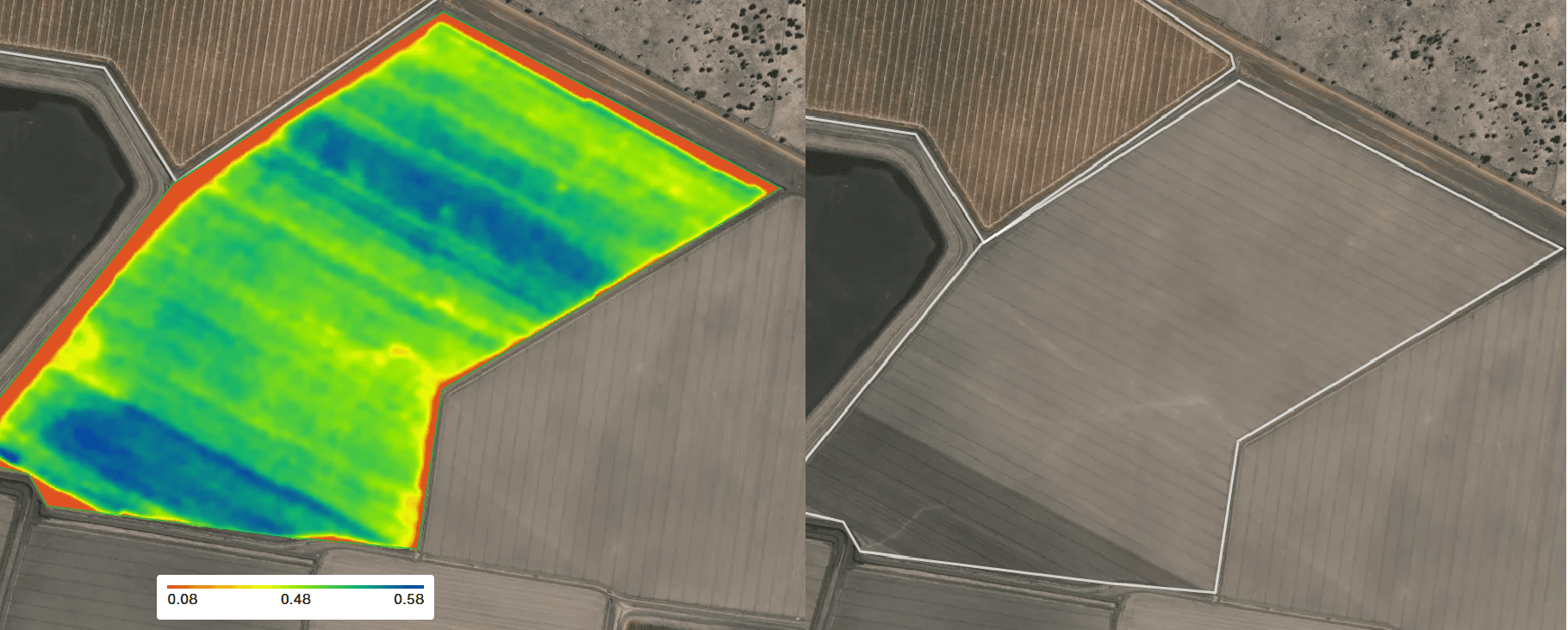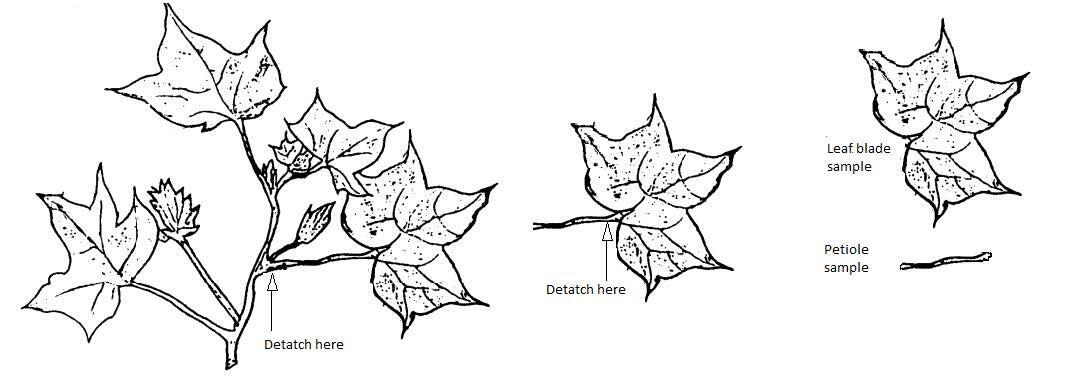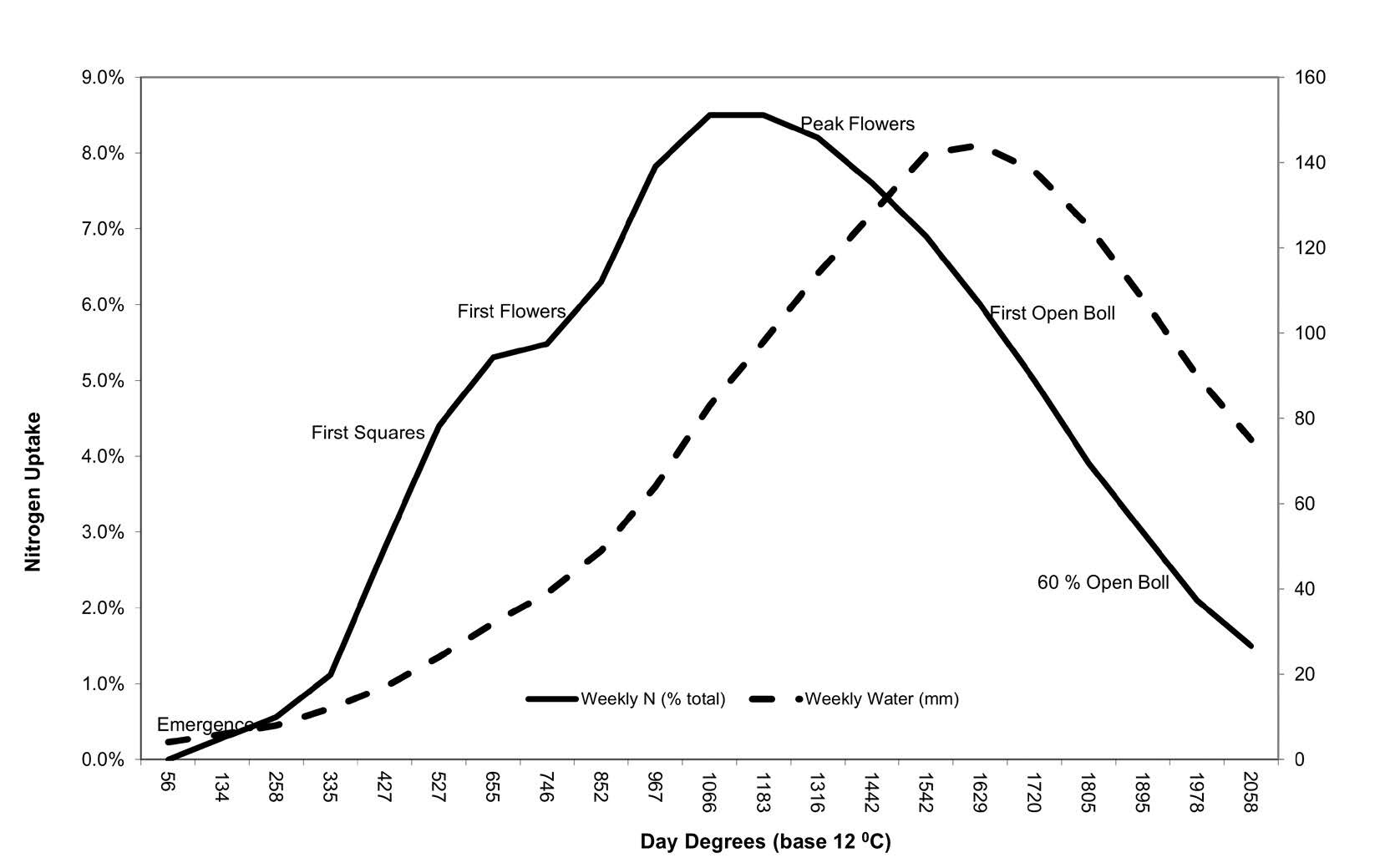
SAMPLE TIMING GUIDE
At a minimum of 1 leaf and 3 petioles, it is suggested that sampling be conducted from the following.
| Sample Type | Growth Stage | Day Degrees | Comment |
|---|---|---|---|
| Leaf (YMB only) | Late Vegetative -Early Squaring | 400-650 | Adequacy of all nutrients prior to the commencement of rapid uptake growth phase |
| Petiole (from YMB) | Early Flowering | 750 - 800 | N and K - baseline |
| Petiole (from YMB) | 900 - 950 | N and K - baseline beginning of rapid uptake | |
| Petiole (from YMB) | 1250 - 1450 | N if growing < 25 nodes | |
| Leaf (YMB only) | First Open Boll | 1450 – 1700 | Peak nutrient demand, how well is the soil/plant coping. |
| Petiole (from YMB) | Cut out | 1800-1950 | Defoliation N vigour or help to understand N status of soil prior to “growing on” in Central Queensland. |
BACKGROUND
It is now generally recognized that an appropriate way of monitoring and managing the effectiveness of a plant nutrition programme for high-yield potential cotton is to track the concentration of nutrients in plant tissue over time. At any sampling time, the concentration of nutrients in the tissue reflects the interaction of growing conditions such as water, light and heat availability and nutrient concentration available from soil and, in some cases, nutrient recycling within the plant. Therefore, if growing conditions are not standardised as much as possible, measurement of the adequacy of a crop nutrition programme may be masked by variability introduced from differences in growing conditions between sampling times.
Much of the inconsistency experienced in the past appears to have resulted from a lack of precision and clarity in protocols for sample collection rather than incorrect critical nutrient concentration ranges. A lack of precision and clarity in sampling protocol leads to large variations in plant tissue nutrient concentration. These reflected the variability within a field than the more valuable change in concentration because of supply and demand across time.
The absolute value of plant tissue nutrient concentrations and the rate and direction of its change are all valuable information in making good nutrient management decisions for cotton. Single measurements of plant tissue nutrient concentration increase the need to ensure growing conditions are optimal and, therefore, increase the risk of a poor decision. Multiple measurements over time provide more data, therefore multiplying the information with which management decisions can be made.
LOCATING SAMPLING REFERENCE POINTS
The Field
Select a location or locations in the field that are easy to relocate and preferably related to some features of the performance of past crops e.g. high or low vigour area, high yield area and or where other observations such as soil moisture and soil chemistry are being made. The combination of soil nutrient and water information, and plant tissue analysis provide a useful platform on which to make decisions.
- Avoid areas of the field such as areas affected by head ditches or tail drains, or leaking channels that may be atypical. This is unless the aim of the sampling programme is to monitor these areas.

- Remote and proximal sensed information such as biomass images, vigour maps, cut and fill maps, yield maps, EM38 maps are also useful additional information in helping sighting sampling reference points away from atypical features.
- Once the sampling reference point is located, samples should be collected in a repeatable pattern within a specified radius of the reference point. A radius of 10 metres should provide low variability due to soil factor sand an adequate number of plants (2000 – 5000) from which to obtain samples.
Cotton Plant
To reduce variability, standardisation of location on plants for collecting tissue is advisable, particularly for N, P, K, as these nutrients are highly mobile in the plant and generally have a large gradient in nutrient concentration between leaves from upper to lower leaves. Ideally, leaves should be undamaged at the same developmental age; standardisation in cotton is commonly for the “youngest mature blade” (YMB) on the main stem. Under different growing conditions, this may occur at the third to the fifth leaf below the terminal.
CONDITIONS
To get the earliest indication of a crop unable to meet peak nutrient demand, it is important to ensure that samples are taken:
- under conditions where the growth rate is unlikely to be limited by any other factor other than nutrients.
- moisture availability and light intensity are similar at each sampling i.e. photosynthesis and transpiration are at or near maximum for the irrigation cycle. To achieve this standardisation of factors such as soil moisture(deficit), time of day and light conditions (cloud cover) should be specified and strictly adhered to for each sampling time.
- allowable variance from these conditions should be set to reschedule sampling if prevailing conditions are outside those where reliable results may be gained.
PLANT PARTS

Leaf Blade (minus petiole)
Leaf blades are most commonly used where a full range of nutrients are to be analysed early and late in the season. There is a large body of interpretation data for leaf tissue analysis with critical concentrations or concentration ranges derived from crop productivity response, but because leaves are storage organs for nutrients, they may be slower to indicate a deficit in supply to the leaf than petioles. For comprehensive nutrient analysis, laboratories require at least 200 g of “wet” leaf blades. This means that the number of leaves required will depend on leaf size, so more will be required when plants are small, and the number will decrease as plants mature.
Petiole
Petiole analysis is most useful for monitoring N and K across time. Water soluble nitrate-N and K are measured; hence, petioles are more responsive to changes in soil N availability and soil and plant K availability. This is because they are conduits for the movements of nutrients from the soil and lower leaves to meet current growth needs and, therefore, usually provide earlier indication of nutrient trends than leaves. Conversely, petioles are also more likely to change rapidly in response to adverse sampling conditions. Petiole analysis is most useful in managing major nutrients just prior to and during flowering and boll filling. There are few published interpretation studies that have developed critical concentrations or concentration ranges from field responses for nutrients other than N, P and K. The relationship between the nitrate-N and phosphate-P trend is useful in understanding the soil moisture conditions during sampling. Laboratories require at least 20 g of “wet” petioles. This means that the number required will depend on size, so more will be required when leaves and petioles are small, and the number will decrease as plants mature.
NOTE – It is vital that the petiole is removed from the leaf blade immediately after picking.
TIMING
When monitoring the progress of the cotton crop it is important to develop a sampling plan just prior to or immediately after sowing. This will allow planning of sampling activities around a known sowing data and estimated crop development.
It is important for interpretation that the crop growth stage at sampling is correctly identified by either calculating Accumulated Growing Day Degrees or closely defining phenological development stages.
The following suggested timings are a guide to sampling that is most useful in managing crop nutrition. Early leaf analysis is timed to detect underlying nutrient issues that may limit the ability to closely manage N and K during peak demand (80 – 90 days post-emergence), whereas the later sample is suggested to assess the crops’ ability to maintain its nutrient status under maximum boll load. Petiole analysis is timed to span the start of and peak N and K demand to ensure tactical N and K application decisions can be made in an informed and timely manner.
SAMPLE HANDLING
- Package in paper bags only. Back Paddock has supplies of barcoded sample bags for leaves and petioles.Contact our service providers or our customer support to arrange supply.
- Keep cool in transit to minimise sap bleeding from tissue.
- Fill in appropriate details on the sample bags, actual days after emergence ( leaf) and day degrees since sowing (petioles) in the information used to improve the accuracy of the interpretation.
- If not using BP service provider, express courier to the laboratory to maintain sample quality.

Download a copy of this detailed sampling guide.
